“], “filter”: { “nextExceptions”: “img, blockquote, div”, “nextContainsExceptions”: “img, blockquote, a.btn, a.o-button”} }”>
“You have to make space in your life for what you want.”
That was what my acupuncturist told me four years ago when I was struggling to become pregnant. She was referring to my desire for a child amidst my chaotic life, which at the time included juggling a corporate career, teaching yoga at night, and running a custom intentional jewelry business on the side.
She was right. There was no space in my life for change, growth, or anything—let alone anyone—new. I was a master of filling up every second of my day. Even though much of my work was deeply fulfilling, I realized it was also an escape.
See also: Burned Out? Yoga Can Help
Why is stillness so difficult?
When we become still or we quiet down, we’re forced to look at what’s really there. Also, what is not there.
When I finally made the choice to slow down, to open up space in my life for possibility, it was one of the harder chapters of my life. I built up the courage and savings to quit my corporate job to focus on my passions. There was more time to focus on what I love, but there was also more time to face my grievances, which I had not expected. My days went from being highly structured and filled with social interaction to being idle and lonely.
At first, I cried a lot. I let my emotions pour out. After years of cluttering up every second of my life, I came to realize that I was so full of unprocessed feelings that I’d successfully avoided most of my life thanks to my unwavering ability to overextend myself in every direction possible.
This is about when my meditation practice began. Even with so much idle time in my schedule after leaving my day job, I felt like I never had enough time or space for myself. I realized that there was an internal component to this feeling that I couldn’t quite wrap my head around. It felt like I needed to create space from the inside out. I felt overwhelmed with grief, anxiety, anger, and self-doubt, and no matter how much time I had in a day, it seemed that I never had enough to feel everything I needed.
One day, I sat on the living room carpet of my tiny West Village apartment and set a timer for two minutes. I had no plan—I just closed my eyes and breathed. I was shocked at how quickly it felt like the timer went off. I started to do it more regularly for longer periods of time. Then I sought out guided meditations. Slowly, my meditation practice grew, and with it so did my confidence in the path I was on. It finally felt like I had space for opportunity. And it finally felt like I had space to believe in myself.
See also: A Beginner’s Guide to Meditation
How being still can be cleansing
Learning to be still and sit with my discomfort was profoundly cleansing. Eventually, my meditation practice became an essential part of my morning hygiene: Wake up, brush my teeth, wash my face, clear my mind.
Saucha, which means “cleanliness” or “purity,” is the first niyama, or yogic rule of conduct that applies to the individual. The concept is not just about cleanliness of the body or of the home, but also cleanliness of the mind.
See also: How Living the Yamas & Niyamas Brought Me Happiness and Love
In Light on Yoga, B.K.S. Iyengar explains that “more important [than the physical cleansing of the body] is the cleansing of the intellect (buddhi) of impure thoughts… This internal cleansing gives radiance and joy. It brings benevolence (saumanasaya) and banishes mental pain, dejection, sorrow and despair (daurmanasya).”
There are two ways to clean a house—you can shove everything under the bed and do a quick vacuum. Or you can take the time to really clean, reorganize, and purify from the inside out. I believe similar approaches exist for cleansing the mind. And just like cleaning a home, this kind of deep internal cleansing takes time. Amidst my shift in careers, I realized there was a whole lot of mess that I had shoved under the bed. And now, time and stillness presented me with no escape route—I had to sort through it.
Saucha is a necessary component to making space. It is a practice of taking time to clear out the impure so that the pure can thrive. Just as you wring out a dish towel before you can wipe down a counter, you have to clear out the clutter in your life holding you back from your internal clarity. It’s difficult to absorb anything new when you’re already fully saturated.
To practice saucha in our lives, we need to take an honest look at the commitments we make. We need to examine whether these commitments are there because of clear intention or whether they are there to fill up our lives to avoid the discomfort of stillness.
In the past two years, as we scrubbed the unwanted from external surfaces, a simultaneous internal cleansing unfolded for many. Now, as we shift back into a world where the bustle of life continues to accelerate, it’s imperative to remember to create space. I’ve heard so many people recently say that they are committing to less on their weekends. We have a new appreciation for downtime. People have learned to be less busy and more still.
I quit my corporate job to pursue my passion for yoga. I didn’t quit to make more space for building a family, but it just so happened that when I opened up space in my life, amongst all the emotions, I became pregnant. If we carelessly cram our lives with all of the same things we did in the past, we will miss an opportunity to experience something new. Without this, we will not retain touch with the growth and space and possibility that so many of us experienced.
See also A Sequence to Create and Hold Space
A Yin Yoga practice to create space for possibility
The following Yin Yoga sequence is designed to help you explore the practice of internal quieting and cleansing to create space. This slower-paced practice is focused on using body weight and gravity to create space in our connective tissues. By inviting a healthy level of discomfort into these tissues, over time we restore fluidity and spaciousness to the connective muscle fibers between our joints.
As you move through the sequence, notice your reactions to slowing down as you hold each shape. Just like creating space in our lives, the effort of creating space deep in our muscle fibers is by no means a comfortable or easeful process. Yin Yoga teaches us to breathe through our discomfort so that we can slow down and create openness from our deepest points of closure.
Note that this sequence is primarily composed of twists and backbends, both of which tend to have energetic and awakening components. As such, this sequence is best suited for the daytime. If you practice during the evening, consider including forward bends after the below sequence to energetically balance and adapt it for the evening.
Have a block or a folded blanket within reach.
Seated Meditation
Sit comfortably, whether cross-legged or on your heels in Vajrasana. A block is always a welcome prop underneath your seat to help elongate the base of your spine and alleviate pressure on your knees. Sit tall and lower your chin slightly. Soften the inner and outer corners of your eyes and gaze steadily at one point or, if it feels natural to let your eyes close, do so. Notice the chatter of the mind when you become still, which is your internal reaction to slowing down. Bring your attention to your breath. Watch the pattern of your inhales and your exhales. Stay here, breathing steadily, for 5 minutes or longer.
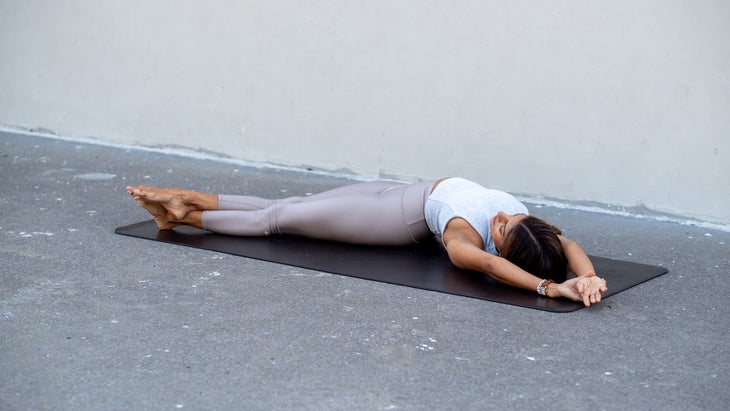
Bananasana
Lie down on your back. Bring your legs together and your arms overhead. Take hold of your left hand with your right and guide your arms over toward the upper right corner of your mat. Move your feet toward the right, as well. Option to cross your left ankle over your right. Keep your hips even on the mat and stretch through your left side body to create space for breathing.
As you continue to hold the pose, you may notice that more space has opened up; listen to this beautiful response from your body and reply by moving your hands and feet further to the right. Stay here for 3 to 5 minutes, come back to center, and slowly bend your knees toward your chest and circle your knees. Repeat on the other side.
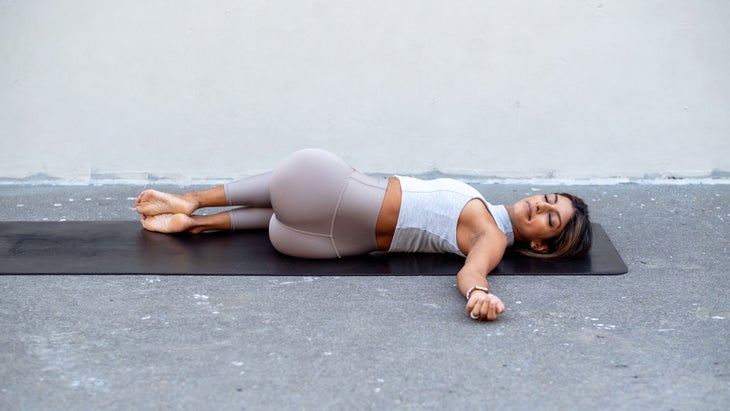
Reclined Supine Twist
From Bananasana, stay on your back and draw your knees in toward your chest. Open your arms straight out to the sides like wings, drape your knees over to the left side, and take your gaze to the right. You can place a block or blanket under your knees for support. The further you draw your legs up toward your chest, the more the twist moves into the upper spine. Conversely, as you move your knees down, the twist moves more toward the lumbar spine. If your right shoulder is floating above the ground, place a blanket underneath it for support. Once you are set up, soften into the support of the ground and let your body fully receive the support that is underneath you. Stay here for 3 to 5 minutes.
To come out, press into your hands and roll slowly back to center. Release your feet down, keeping your knees bent, and windshield-wiper your legs from side-to-side. Repeat on the other side.
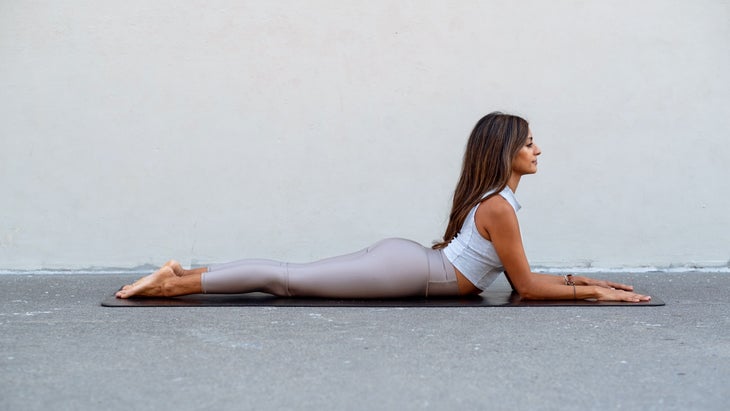
Sphinx Pose
From lying on your back, roll over to your right side and pause briefly in fetus position. Make your way onto your belly. Take your elbows about an inch in front of your shoulders and align your forearms so they are parallel with the long edges of your mat. If the sensation in your lower back feels like too much, you can inch your elbows further forward and move your chest closer to the ground. You can keep your head up or prop your forehead on a block to rest your neck. Remain here for 3 to 5 minutes.
To come out, lower your chest to the floor. Turn your head to the right, cactus your arms, and bring your right knee upward in line with your hip while you keep your right ankle on the floor. Hug the planet for about 30 seconds. Switch sides. Return to center and push yourself back to hands and knees.
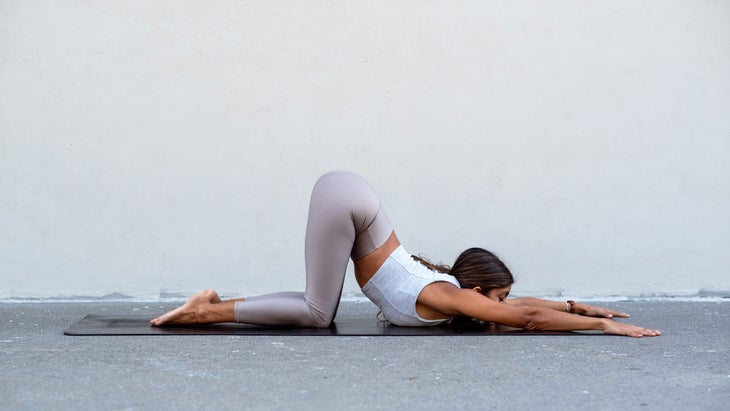
Melting Heart
From hands and knees, align your hips with your knees and walk your hands forward as you lower your chest and forehead to the ground. Option to prop both the chest and the forehead up for support with blocks or blankets. If your hands are slipping, you can try holding onto the edge of your mat for resistance. Your forehead can stay down on your block or mat, or you can take your gaze forward and rest on your chin. Observe the sense of spaciousness you’re creating in the middle and upper back. Breathe into this shape for 3 to 5 minutes.
To come out of the shape, pull yourself forward to hands and knees and take a few slow rounds of Cat–Cow.
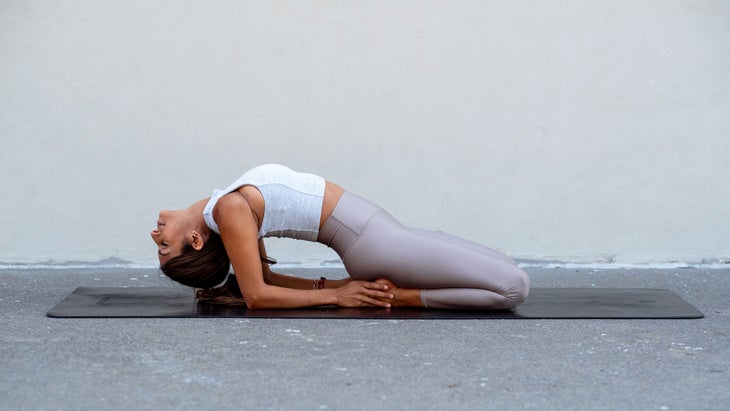
Saddle
From hands and knees, come to sit on your heels and widen your knees slightly. If this feels uncomfortable on your knees, try placing a blanket underneath you for extra cushioning. Walk your hands back alongside your hips and lean into your hands to create a small arch in your low back. Pause here and assess whether this may be enough sensation for you—remember that in Yin, you want to settle in a place where you can sustain a longer hold.
For more intense sensation, continue to lower down onto your forearms. Option to release your head back if it feels OK for your neck. Another option is to support this shape with blocks underneath your upper back and head. Using the blocks may help you feel a greater opening across the upper chest and shoulders. Breathe into the opening of your entire front body for 3 to 5 minutes.
To come out of the pose, reverse and prop up onto your forearms first, then press into your hands and come back to an upright seat on your heels. Pause here. Slide your hips to either side of your heels, bring your feet in front of you on the mat with your knees bent, and windshield wiper your legs a few times.
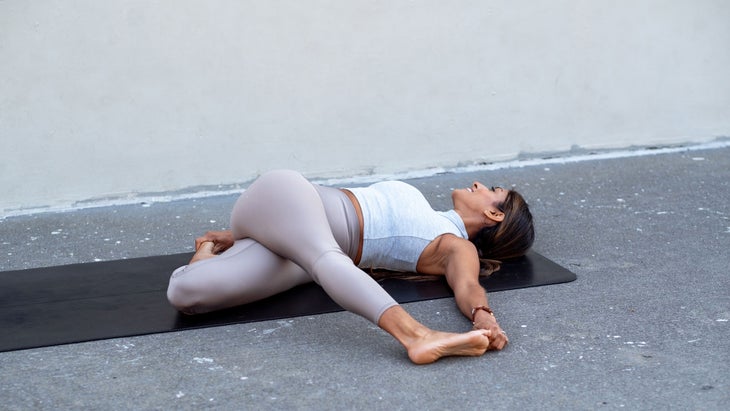
Cat Pulling Its Tail
From seated, come to lie down on your back. Bend your right knee in toward your chest, and cross it over the left side of your body. Bend your left leg as well and bring your left heel toward your bum while you keep your left knee in line with your hip. With your right hand, reach for the toes of your left foot. Option to straighten the top right leg and grab the outer edge of the foot with the left hand. Remain here for 3 to 5 minutes.
If this shape feels too intense, a simple supine twist is also a welcome option. Focus on the feeling of length in your spine. After holding the pose, release back to center and hug your knees into your chest for a few circles. Repeat on the other side.

Viparita Karani Variation
Lie on your back, bend your knees, and lift your hips. Slide a folded blanket or a block on the lowest height underneath your sacrum. Take your arms straight out alongside you, bend your knees, and lift your legs up. Stretch your feet toward the sky and let your toes reach upward. Release any tension in your fingers, jaw, even the space between your eyebrows. Stay here for at least 5 minutes. Bring your focus to the sense of openness you’ve created by taking the time to slow down and breathe through discomfort.
When you’re ready, bend your knees and slowly bring your feet back to the mat. Pause before you return to life.
See: more Yin Yoga practices
About our contributor
Neeti Narula is a yoga and meditation teacher in New York City. Her classes are inspired by various schools of yoga. She is known for teaching alignment-based classes infused with thematic dharma and yoga philosophy. Neeti believes that the way you move and breathe on your mat shapes the way you move and breathe in your life. You can practice with her in person at Modo Yoga NYC. To learn more about Neeti, check out her Instagram @neeti.narula.

